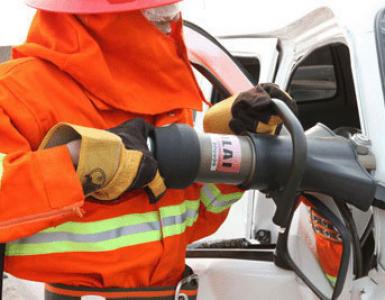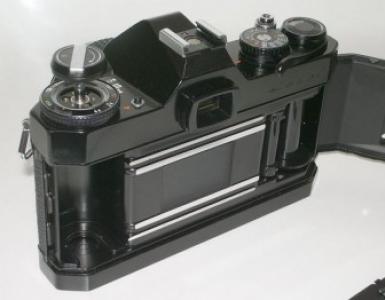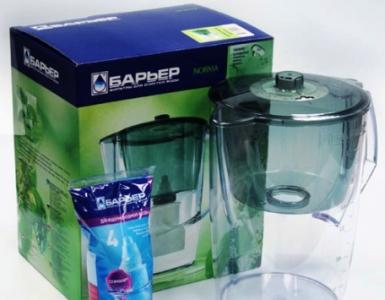Al automata current characteristics. Main technical characteristics of circuit breakers
Even in good electrical wiring and with good equipment connected to it, there are emergency modes. Because the cable lines can not withstand the overload for a long time, they heat up, the insulation of the conductors melts. Then there is a fire and a fire. To protect electrical appliances and wiring from abnormal operating modes, an automatic switch is used that trips when the current rises.
To describe the principle of the operation of the circuit-breaker, let us consider the operation of two independent releases acting in its composition. To disable short circuits (short circuit) is a release of instantaneous action (cutoff), also called electromagnetic. The principle of its operation is based on the movement of the rod of the coil when a current flows through it. While its value is in the allowable range, no movement of the rod occurs. But when it exceeds a certain value (setpoint), the rod hits the trip plate and the circuit breaker switches off under the action of the spring.
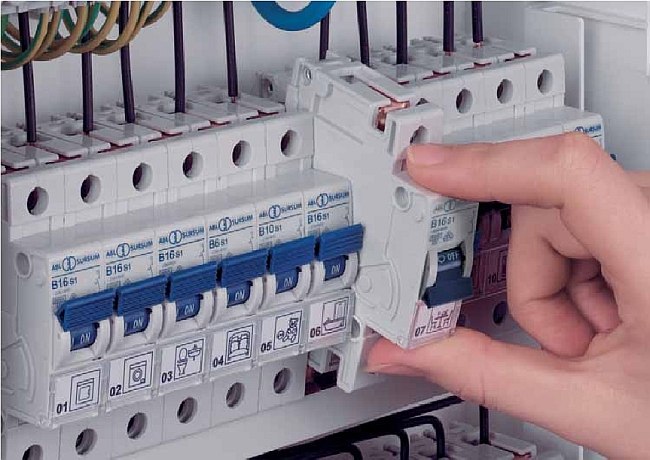
The overload release, called still thermal, operates with time delay. It is connected in series with the electromagnetic one and is a bimetallic plate starting to bend under a certain current. The value of it for different models is set in 1.3 - 1.45 times the nominal, and the circuit breaker will shut down if the impact on it does not stop. The principle of an inverse characteristic is based on the operation of a thermal release: the more current passes through the plate, the faster it bends and the disconnection occurs more quickly. At the end of the turn, the plate will press against the trip plate. Any automatic circuit breaker with a thermomagnetic release has this principle of operation.
Classification of household circuit breakers
Nominal currents of modular products of standard sizes can be selected from the range from 0.5 to 63 A.
| 0,5 | 1,0 | 1,6 | 2,0 | 2,5 | 3,0 | 4,0 | 5,0 | 6,0 | 8,0 | 10 | 13 | 16 | 20 | 25 | 32 | 40 | 50 | 63 |
Models for 80, 100 and 125 A are available in enclosures of increased dimensions
The circuit breaker includes one, two, three or four poles depending on the purpose:

Some species automatic switches
- 1 pole - for single-phase distribution networks of permanent and aC voltage;
- 2 poles - for power input in single-phase networks receiving power from the power line. The second pole is intended for switching of the neutral wire, since the presence of a life-threatening potential is not excluded. Two poles are also necessary for DC circuits;
- 3 poles - for three-phase networks of alternating voltage;
- 4 poles - for three-phase networks with isolated neutral and the cases when the rules require disconnection at fault in the zero working conductor.
The rated ultimate breaking capacity is the maximum short-circuit current that can disconnect the circuit breaker without harm to itself. If it is exceeded, the case can be destroyed. Modular automatic machines have a breaking capacity from 4500 to 25000 A.
Classes (response characteristics) of circuit breakers
Instantaneous releases are not manufactured to the exact amount of operation. It has a spread that falls within a certain range. Depending on this for the modular series, classes or characteristics of operation are distinguished.
There are other classes, but their use is limited to specialized products of industrial application.
Automata classes "B" and "C" are most often used in household networks. Class "B" is installed directly at the consumer, and "C" can protect a group of consumers who have protection class "B". This ensures the necessary sensitivity of the work, because with increasing distance from the power source, the short-circuit current decreases, and the "C" class device can not feel it.

There is an opinion that this ensures selectivity (selectivity) of disconnection of damaged areas. That is, only network sections with damage will be disconnected. But, as practice has shown, if the magnitude of the fault is sufficient for the operation of the two automatically connected machines with the characteristics "B" and "C", they will work simultaneously. After all, the operating time of their cutoffs is the same. Therefore, disconnecting the entire apartment with a short-circuit in a socket protected personally, in most cases, is inevitable. But it's better than not.
Selectivity can be provided by a circuit breaker with a semiconductor release, which can be set to delay the tripping of the cutoff. It implements a different principle of operation - the use of sensors and electronic scheme, which processes the values of the quantities measured by them. But such products are used in industrial installations and are not used in everyday life. They allow you to set the exact value of the cut-off and overload response parameters, and they themselves are designed for loads of hundreds and thousands of amperes.
The release with characteristic "D" is used to protect electric motors, which consume a current several times higher than the rated current.

Example of class C characteristic: a - inverse time delay zone, b - cut-off zone
The operating time of the thermal trip unit can be determined by the time-current characteristic. It is unique for each type and is listed in the manufacturer's passport data. The figure shows an example of a class "C" characteristic. There are two zones on it:
- A - inverse time delay;
- B - cut-off.
All characteristics of real products do not go beyond the limits limited by two lines indicating the permissible spread of parameters.
The circuit breaker can be supplemented with elements that perform service functions. Here are some of them:
- state contacts, serve for generating information for automation devices about the position of power contacts;
- emergency contacts that close when disconnected from protection;
- releases of the minimum (maximum) voltage, disconnecting the machine when the voltage in the mains is lowered (increased);
- independent releases that disconnect the machine from an external control device. Used to turn off consumers when a fire alarm is triggered.

Examples of additional accessories for the modular series
To install additional accessories from the body of the machine, the plugs closing the holes for connection to its mechanical part are removed. The element itself is fixed on the body.
Devices for circuits for constant voltage

Example of a device for circuits for constant voltage
Due to the fact that the designs of electromagnetic coils for AC voltage differ from constant ones, special automatic machines are used to protect these circuits. Outwardly, they can be distinguished by the polarity marking on the housing. To observe this polarity is necessary: if the switching is wrong, the cutoff will not work. The rest of the principle of work does not change.
They are used in the control and power supply circuits of consumers working on batteries.
Any circuit breaker needs a time to trip. It can be a hundredths of a second, or maybe several minutes. It all depends on the current that will flow through the circuit breaker. If the cable and the machine are chosen correctly, you can not be afraid that with increased current, the insulation on your wires will not melt, for example, in 30 seconds, which are necessary for the circuit breaker to work from a certain overload.
There are such interesting time-current characteristics of circuit breakers - these are such beautiful graphs of the curves of the dependence of the operating time on the magnitude of the current. They are indicated on the machines with the letters B, C and D.
These letters stand in front of the value of the machine's denomination. Below are the usual graphs, by which you can determine after what time the load will be de-energized at an increased current or its jump. Did you go to school? Do you know how to work with schedules? Then immediately understand. The vertical axis is the time in seconds. The horizontal scale is the ratio of the current flowing through the wires to the rated current of the I / In machine.
What is the difference between the time-current characteristics of circuit breakers "B", "C" and "D"? It's simple! They differ in the value of the ratio of the current flowing to the rated current I / In.
If all the same there were questions, then we go further to understand together. I will quote everything on specific examples, as this will be more understandable than if I explain it on my fingers.
Let's say that we have a 10A circuit breaker with the characteristic B. We chose 10A because it will be easier to count, and they are often used in everyday life.
For example, there was an emergency. My wife asked me to hang up the carpet, and when you drilled it, you got into the wire coming from the switchbox. Babah! Around the silence and dark. Here, you simply cut the wires of the wire with a drill, and a short circuit occurred. It was so? I admit that I had such a thing when I was young.
In this situation, circuit breakers with characteristic B are triggered almost instantly, when the current in the network exceeds the value of the machine's rating by 3-5 times. In our case, this current lies in the range of 30-50 amperes. Of course, in the event of a short circuit, the current increases by a factor of hundreds, but the automatic device with characteristic B has a 3-5-fold increase. Here comes the electromagnetic release.
We look at the graphs below and see that at a current of 50A, the automaton will work after 0.01 second. This is obtained from here. The current at the short-circuit is divided by the rated current of the machine, i.e. 50A / 10A = 5. Now on the horizontal scale, find the number 5 and draw a conditional line (in the figure it is highlighted in red) vertically up to the intersection with the curve. We set the point and draw a conditional horizontal line from it to the time axis. We got approximately 0.01 seconds. Similarly, when the network is overloaded with a current of 15A, our ratio is 1.5 and the delay time for triggering is 30 seconds. Here, the machine will shut down due to the operation of the thermal release. If the cross-section of the wire is calculated correctly, its insulation with such current will not be able to melt during this time. You are protected.

Above we considered the lower curve, but in the picture they can be identified 3 pcs. What is this all for? Let's figure it out. These curves are intended for different states of circuit breakers: "cold" (upper curve) and "hot" (lower curve), and the graph itself is compiled for an ambient temperature of + 30 ° C. On the dotted line, the shutdown time for an automaton with a rating not higher than 32A is calculated.
For the cold state of the circuit-breaker with characteristic B for the example described above, the delay time for the trip will be at a current of 50A - 0.04 sec. and at a current of 15 A - 4000 s. (about 67 minutes). In the figure above, this is shown in blue.
Also keep in mind that the machines are in different places - in the apartment, in the entrance, on the street, etc. For example, in winter the temperature is +25 at the entrance, +16 on the street, -25 on the street. Accordingly, the temperature of the elements of the release is different and it needs different time to warm up and make the machine operate.
Still here there is a correction factor. The lower the ambient temperature, the greater the current through itself will pass the machine and vice versa. With the same load in hot and cold rooms, the same machine will operate at different current values. These fluctuations are not significant and this issue becomes relevant when the circuit breaker is heavily loaded and operates at its limit. It is worthwhile to rise the ambient temperature, as it can turn off the load. Often such a question arises in the summer in hot rooms.
Now I will say a few words about the time-current characteristics of circuit breakers C and D. Their essence lies in the fact that all characteristics curves are shifted to the right, i.e. thus, the time of their activation increases. The machine with the characteristic C in case of a short circuit will work when the current in the network exceeds the rated current of the machine itself by 5-10 times. An automaton with a characteristic D with a short circuit will work when the current in the network exceeds the rated current of the machine itself by 10-20 times.
From the graphs we get (see below). For automatic machine at 10A of the characteristic C, the response time will already be: at a current of 50A, about 0.02 seconds. and at a current of 15A for about 40 seconds. This is for the hot state of the machine (red color). For a cold state (blue color), we get: at a current of 50A, about 27 seconds. and at a current of 15A about 5000 seconds. (83 min.).


For an automatic machine with 10A characteristics D (see the graphs below), the response time will already be: at a current of 50A, about 1.5 seconds. and at a current of 15A for about 40 seconds. This is for the hot state of the machine (red color). For a cold state (blue color), we get: at a current of 50A, about 30 seconds. and at a current of 15A about 6000 seconds. (100 min.).


Here you see what is the difference in the time values when reloading machines. This, too, must be known and taken into account when choosing them.
Typically, for apartments use circuit breakers with a characteristic B, and in production - C and D. Although very often you can find in the floor plates automatic machines with the parameter C. Another machines with the parameter B on sale are rare.
Also note that each machine can pass through itself a current greater than 1.13 times the rated current. This can be seen from the graph. You see the value of 1,13 on the horizontal axis and if you keep the conditional line vertically up, it will never cross the time curve. Consequently, the machine at such a current does not work. Therefore, choose a cable with a larger cross-section, i.e. with a margin. Better insure yourself.
See for which circuit breakers which corresponds to the non-tripping current. This is also taken into account when choosing a circuit breaker at nominal and cable.
For example, for a load that consumes a current of 25A, you have chosen a cable with a cross section of 2.5mm2. Then the wife was going to cook dinner, drink tea at the same time, to defrost the meat in the microwave and also brought a hair dryer (which you did not take into account in your calculations) to the kitchen to dry your hair. Thus, instead of 25A you can get in the network 28A, and the machine will not work here, since it will work at a current of 25A * 1.13 = 28.25A. It can be seen from the table that for such a current a wire with a cross section of at least 3 mm2 is already needed. But we have a wire cross-section of 2.5 mm2 and therefore it will bask and melt the insulation.
Moreover, take note that many manufacturers are cunning in the manufacture of cable. Make it according to the specifications ( specifications), at which the cable section is reduced. I adhere to this opinion in the choice of cable and circuit breakers, that it is better to take everything with a reasonable margin than the expected load.
Do not forget to smile:
And do not go to work for me? thought the electrician.
And he did not go ...
The time-current characteristic of the circuit-breaker determines the response time of the automaton as a function of the time and force of the current flowing through the circuit breaker
Let's consider characteristics of operation of the machine by an example 16-amp machine with time-current characteristic C.
The above graph of the time-current characteristic shows how the 16-amp machine with the characteristic C will work when the currents flow in at different times. The time-current characteristic curve takes into account that the machine includes two releases, thermal The action of the thermal release is based on the property electric current to heat the conductor, in proportion to the current flowing through it. The electrically heated bimetallic plate bends and activates the cocked release mechanism of the machine. and electromagnetic The effect of the electromagnetic release is based on the occurrence of a magnetic field proportional to the current flowing through the coil of the current release. With a shock current characteristic of a short circuit, a strong magnetic field draws in the magnetic core of the release, which drives the clipped release mechanism of the contacts of the machine. and shows how the circuit-breaker reacts to different currents, that is, at what speed the machine switches off depending on the current flowing through it.
In the above, as an example, the graph of the time-current characteristic C of the circuit-breaker is 16-ampere, the time in seconds, on the horizontal axis, is indicated in the horizontal axis, the current strength is precisely the 16-amp machine, which differs from the usual characteristic graphs on which the value of the reduced current in units of the rated current of the machine is indicated. On the graph, you can distinguish two main zones, this is the zone of the automatic device, located between two lines of graphs and the rest of the graph area, where the machine has not worked (to the left of the left line of the graph) and where it worked (to the right of the right line of the chart). The fact that the machine is triggered at some particular current value, and in the current range, is conditioned by the analogous principles of the operation of both releases, which creates technical difficulties for fine tuning the machine, in addition, the regulations governing the operation of circuit breakers allow such a spread in time and operating current.
The main protection tasks implemented by the trip units are different:
- The thermal release protects the network from a prolonged but relatively small excess of the permissible current;
- The electromagnetic release protects the network from short-circuit currents characterized by a high slew rate and very large (thousands of amperes) values.
Characteristic curve of the thermal release of the automaton
In the image above, the pickup zone thermal release , which is indicated by a yellow arrow. In the indicated range of currents, that is from zero and up to 80-160 amperes (this is just the range of operation from five times to ten times the nominal current of the machine), the thermal release basically works. The graph shows that at a current equal to 16 Amps, the C16 machine should shut down in a time of 2000 seconds or more, that is protective actuation machine will occur more than half an hour of current flow with a force equal to the nominal value of the machine. As the amperage increases, the operating time decreases and becomes fast, that is, the machine is guaranteed to turn off in less than 10 seconds with a tenfold increase in the rated current. Here it is worth noting that this is a guaranteed shutdown, in fact, the machine may be disconnected before, for example, at a current of 80 amperes, the time of the machine shutdown will be from 0.02 to 20 seconds. It can also be said that for 1 second the machine can switch off at any current in the range from 80 to 160 amperes., conditionally beginning for the characteristic C with 120 Ampere. The presence of an electromagnetic release in the machine is due to its high speed of activation, which allows you to disable overcurrent in less than 0.02 seconds. As an example, we can say that when the short circuit in the circuit is protected by the automatic device and the current is equal to 320 amperes, the time for switching off the machine will be in the range from 0.0075 to 0.0170 seconds, which will remove the power from the emergency circuit and protect the machine itself, electrical wiring and a short-circuited electrical appliance from fire and complete destruction.
Circuit breakers serve for emergency disconnection of the circuit in case of exceeding the current intensity. They allow to protect devices from breakage or failure at unacceptable loads and to prevent fire.
Automatic switches
Operating principle
The principle of the circuit-breaker is quite simple. The design of the switches includes two types of releases: electromagnetic and thermal. The first - instantly fires at a strong current jump. The electromagnetic release consists of a solenoid with a steel movable core, which is held by a spring. If a given current exponent is exceeded, the electromagnetic field in the coil is induced, which leads to retraction of the coil. As a result, the resistance mechanism works. If the operating mode is standard, the magnetic field is also induced, but it is insufficient to force the spring resistance to be overcome.

Types of releases
The second - the thermal release has in its composition a bimetallic plate, which is designed for a certain current. If the flowing current exceeds the permissible values, the plate from the bimetal heats up and bends, which also causes the mains to disconnect.
The operation of the circuit breaker is based on these two releases, since they are ineffective separately.
The electromagnetic release releases quickly with a small shock. But if you take into account that some high-performance motors need a stronger current during start-up than in normal operating conditions, then there is no need for the switch to operate. In domestic conditions such powerful devices are a vacuum cleaner, an electric kettle, a microwave oven. For a thermal release, it takes some time to heat and melt the plate, which can be critical for household or industrial appliances subjected to a high current jump. In a residential building, the influence of strong current on the refrigerator, computer and office equipment will be very harmful.

The structure of the electromagnetic release
That is why two types of release are used in automatic circuit breakers in common, and for a period of time from a surge of current to emergency shutdown, the current characteristic of the automatic device is responsible.
Types of characteristics
The current characteristic determines the relationship between the increase in current strength and the instant of emergency shutdown by means of protective circuit breaker. Since different conditions of current consumption in domestic and industrial conditions require different network voltages, the protection circuit-breakers also have different power and response characteristics. The circuit breakers are produced with current ratings from 6 to 125 amperes. In the home most often used protective devices for 16 or 20 amperes. For a large private house is suitable device in 25A. As for the time characteristic, it is denoted by Latin letters on the switch label. The most common are three types: B, C, D. This mark indicates the sensitivity of the electromagnetic release or the speed of instantaneous triggering with a limiting increase in amperage.
The trigger range for these three types is:
C-5-10XIn,
D-10-20XIn.
The interpretation of the parameters of different types of automatic machines is as follows: if the machine is designed for a current strength of 20 amperes, this indicator is multiplied by the data of the operating range, and the sensitivity characteristic of the circuit breaker is obtained.
20 * (3 ... 5) = 60 ... 100 A
Thus, a Type B machine at 20 amperes will turn off instantly with a current strength of over 100 amperes. The limit for its operation is 60A, and for 60 to 100A current the shutdown speed will depend on the heating rate of the bimetallic plate of the heat sensor.
When choosing an electrical protective device for home or industrial purposes, you should not only calculate its power, based on the current consumed in the room, but also pay attention to the type of the time-current characteristic.
Automatic machines of identical power, but of different types of time-current characteristics behave differently. In a situation where a B-type machine will operate from a fraction of a second, the same type C fuse will react only after 5-7 seconds, which can adversely affect the devices and the mains supply. In a residential apartment, where many highly sensitive devices with low current consumption, it is necessary to install type B switches. For large commercial, semi-industrial or office premises where there are powerful devices, a Type C automatic machine can be used. Type D is used exclusively at industrial facilities where there are motors with powerful starting characteristics.
Time characteristic curve
To describe the timing characteristics of safety circuit breakers, a graph of functions is often used, where the decay time of the mains is recorded vertically on the ordinate axis in seconds and tenths of a second, and the growth indices of the current are indicated horizontally on the abscissa. In this graph, the increase is determined by dividing the current in the network by the rated current of the I / In machine.

Graph of the function of the time-current curve
The two curves shown are responsible for the indicators in the cold state (from above) and the warmed state (from below).
Additional information: Conditionally, also the lower part of the curve, sharply rushing to the right, is considered the zone of operation of the electromagnetic release, and its left part, smoothly descending downwards, is the zone of the thermal release.
To the left of the curve is the length of time before the circuit-breaker trips, and to the right after disengagement. The curve itself represents the instant of shutdown. Traditionally, the time-current characteristics in the form of a graph of functions are shown for the operation of automata at an ambient temperature of +30 degrees.
If you look at the characteristic for a Type B machine with a range of 3 to 5 In, you can see the following: the mains failure time at the passing current of 3 In is 0.02 seconds warm-up and 35 seconds cold. For machines with a capacity of more than 32A, the indicator in the cold state can reach 80 seconds.
If the passing current for the same type of machine is 5In, then in the hot state, the machine will work in 0.01 second and 0.04 seconds in the cold one.

The graph of a function of an automaton of type C
A Type C machine does not work at a current of 3In, and at a current of 5In it will shut off in 0.02 seconds in warm-up and in 11 seconds in a cooled state. For this reason, it is not necessary to install type C fuses in a residential house, where household appliances are not designed for high current consumption and sudden changes. A high-sensitivity Type B machine will provide reliable protection for wiring and electrical equipment. If, in a large private house, a distribution machine is used, a type C switch of correctly calculated power can be placed at the input, and type B machines can be used for individual points.
Device. Video
About the features of the ABB circuit breaker device, the video will be described below.
To make the right choice of the circuit breaker (АВ), it is necessary to have full information about existing types of this device, as well as to know the network parameters, the characteristics of electrical appliances.
Circuit-breakers are usually selected for four key parameters - rated breaking capacity, number of poles, time-current characteristic, rated operating current.
Parameter # 1. Rated breaking capacity
This characteristic indicates the permissible short-circuit current (AC) at which the circuit breaker will trip and, after opening the circuit, de-energize the wiring and the devices connected to it. In this parameter, three types of automata are divided: 4.5 kA, 6 kA, 10 kA.
- Automatic machines on 4.5 kA (4500 A) Usually used to exclude damage to power lines of private residential units. The resistance of the wiring from the substation to the fault location is approximately 0.05 Ohm, which gives a limiting current of about 500 A.
- Devices for 6 kA (6000 A) They are used to protect the housing sector from public places, public places where the resistance of the lines can reach 0.04 Ohm, which increases the probability of getting a short to 5.5 kA.
- Switches for 10 kA (10000 A) Used to protect electrical installations for industrial use. Current up to 10000 A can occur in a short electrical circuit, located close to the substation.
Before choosing the optimum modification of the circuit breaker, it is important to understand whether short-circuit currents exceeding 4.5 kA or 6 kA are possible.
The rated breaking capacity is indicated in the documentation for the switch and on the case in the form of a cipher - 4500A, 600A, 10000A or 4.5kA, 6kA, 10kA. On the front of the device there is information about the manufacturer, model, the nominal voltage, consisting of time-current data, operating current (+)
Switching off the machine occurs when the setpoints are set. Most often for household needs, 6000 A modular switches are used. Models 4500 A are not used to protect modern power grids, and in some countries they are forbidden to operate.
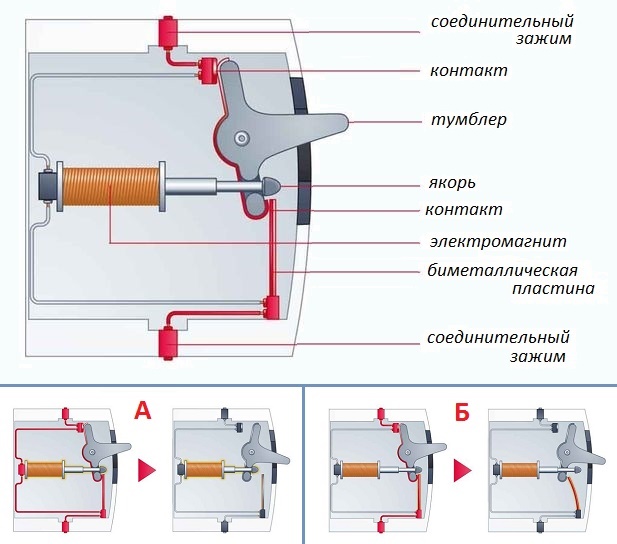
When registering with an automatic short-circuit breaker, an electromagnetic coil (situation A) is produced. When the rated currents are exceeded, the network opens the bimetallic plate (situation B)
The operation of the circuit breaker is to protect the wiring (and not the equipment and users) from short circuit and from reflow insulation when passing currents above the rated values.
Parameter # 2. Number of poles
This characteristic indicates the maximum possible number of wires that can be connected to the AV to protect the network. Their shutdown occurs when an emergency occurs (during exceeding the permissible current values or exceeding the time-current curve level).
Features of single-pole automata
The single-pole type switch is the simplest modification of the machine. It is designed to protect individual circuits, as well as single-phase, two-phase, three-phase electrical wiring. To the design of the switch it is possible to connect 2 wires - the power wire and the outgoing wire.
The function of the device of this class is only to protect the wire from fire. The neutral of the wiring is placed on the zero bus, thus bypassing the machine, and the ground wire is connected separately to the ground bus.
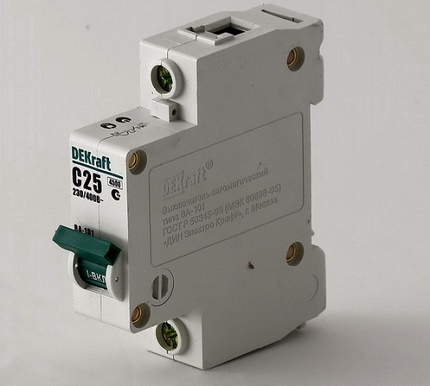
Connection of a single-pole AB is made by single-core wire, but sometimes two-wire cables are used. Connect the power from the top of the machine, and the protected line from the bottom, which simplifies installation. The installation takes place on an 18-millimeter din rail
A single-pole machine does not perform an opening function, because when it is forcedly disconnected, the phase line is broken and the neutral is connected to a voltage source, which does not give a 100% guarantee of protection.
Characteristics of bipolar switches
When it is necessary to completely disconnect the mains from the voltage, a two-pole automatic machine is used. It is used as an input, when during a short circuit or a malfunction of the network all wiring is de-energized simultaneously. This allows you to conduct timely work on the repair and modernization of chains is absolutely safe.
Two-pole automata are used in cases where a separate switch is required for a single-phase electrical appliance, for example, a water heater, a boiler, or a machine.
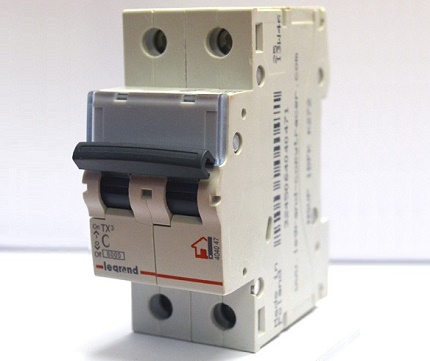
The connection of the two-pole automatic machine takes into account the electrical protection scheme using a 1- or 2-wire cable (the number of wires depends on the circuit of the connection). Mounting is carried out on a 36 mm din rail
Connect the machine to the device to be protected using 4 wires, two of which are power wires (one of them is directly connected to the network and the other supplies power to the jumper) and two - the outgoing wires that need protection, they can be 1-, 2- , 3-wire.
Three-pole modification of circuit breakers
Three-pole machines are used to protect the three-phase 3- or 4-wire network. They are suitable for connection as a star (the middle wire is left without protection, and the phase wires are connected to the poles) or a triangle (with no central wire).
If an accident occurs on one of the lines, the other two are switched off.
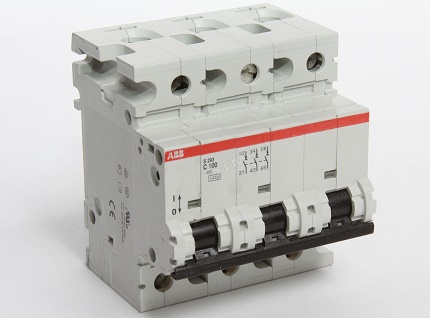
Connection of the three-pole AB is made by 1-, 2-, 3- wire wires. For installation, a DIN rail with a width of 54 mm
The three-pole switch serves as an input and common for all types of three-phase loads. Often, modifications are used in industry to provide current to electric motors.
Up to 6 wires are connected to the model, 3 of them are represented by phase conductors of a three-phase electrical network. The remaining 3 are protected. They represent three single-phase or one three-phase wiring.
Application of a four phase machine
To protect a three-phase, four-phase electrical network, for example, a powerful engine connected by the star principle, a four-phase automatic device is used. It is used as an input switch for a three-phase four-wire network.
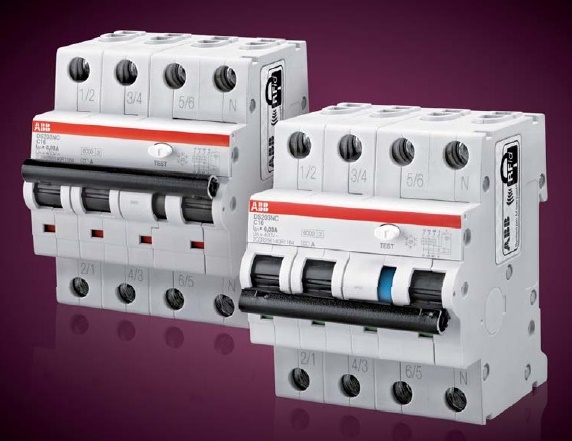
Connection of the four-pole switch is made by 1-, 2-, 3-, 4-wire wire, the circuit depends on the type of connection, the body is mounted on a 73 mm din rail
It is possible to connect eight wires to the hull of the machine, of which four are phase conductors of the electrical network (one of them is neutral) and four are represented by outgoing wires (3 phase and 1 neutral).
Parameter # 3. Time-current characteristic
AB can have the same index of the nominal load power, but the characteristics of power consumption by devices can be different. The power consumption can come unevenly, vary depending on the type and load, as well as when switching on, off or constant operation of a device.
The fluctuations in the power consumption can be quite significant, and the range of their variations is wide. This leads to the shutdown of the machine in connection with the excess of the rated current, which is considered a false disconnection of the network.
To exclude the possibility of an inadvertent tripping of a fuse in case of non-emergency standard changes (increase of current strength, power change), automata with definite time-current characteristics (BTX) are used. This allows the operation of switches with the same current parameters with arbitrary permissible loads without false trips.
BTX show, after what time the switch will work and which indicators of the ratio of the current and direct current machine at the same time.
Features of automata with characteristic B
The machine with the specified characteristic is switched off in a time of 5-20 seconds. The current index is 3-5 nominal current of the machine. These modifications are used to protect circuits that feed household appliances.
Most often, the model is used to protect the wiring of apartments, private houses.
Characteristic C - working principles
The machine with the nomenclature designation C is switched off within a time of 1-10 seconds at 5-10 rated currents.
Use switches of this group in all areas - in everyday life, construction, industry, but they are most in demand for electrical protection of apartments, houses, living quarters.
Operation of circuit breakers with characteristic D
Automata D-class are used in industry and are represented by three-pole and four-pole modifications. They are used to protect powerful electric motors and various 3-phase devices. The response time AB is 1-10 seconds at a current multiple of 10-14, which allows it to be used effectively to protect various entries.
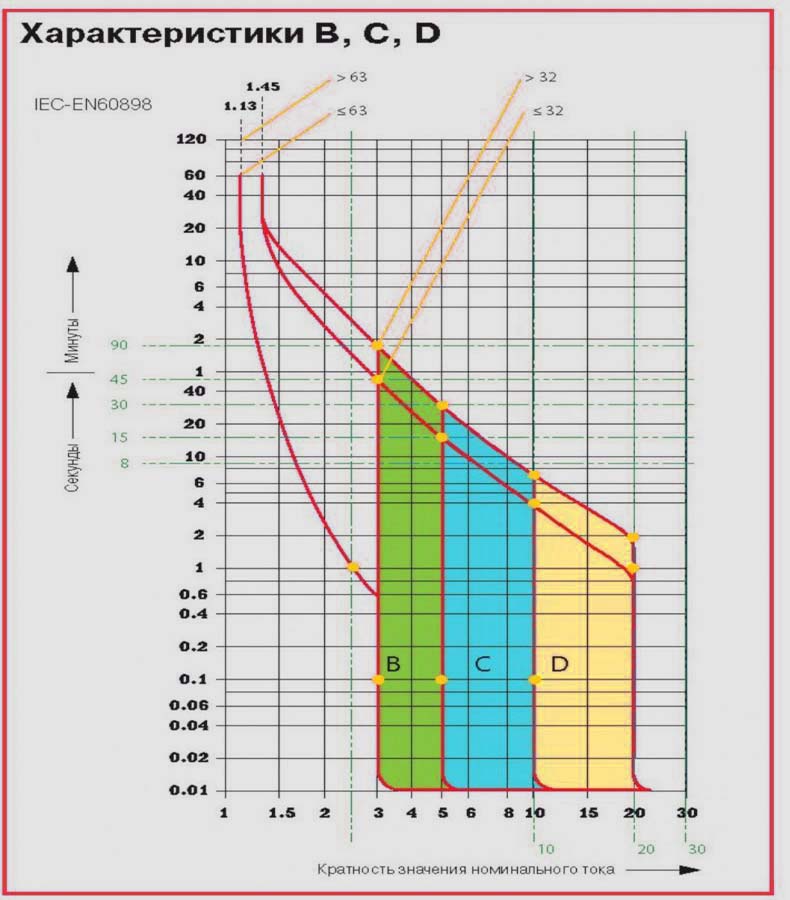
At the bottom of the graph, the multiplicity of the rated current is given, along the vertical line is the shutdown time. For characteristic B, the trip occurs at 3-5 times the excess of the active current above the rated current, for C - 5-10 times, for D - 10-14 times (+)
Powerful industrial motors operate exclusively with AB with characteristic D.
Parameter # 4. Rated operating current
In total, there are 12 modifications of automatic machines, differing in terms of rated operating current - 1A, 2A, 3A, 6A, 10A, 16A, 20A, 25A, 32A, 40A. The parameter is responsible for the speed of operation of the machine when the current exceeds the rated current.
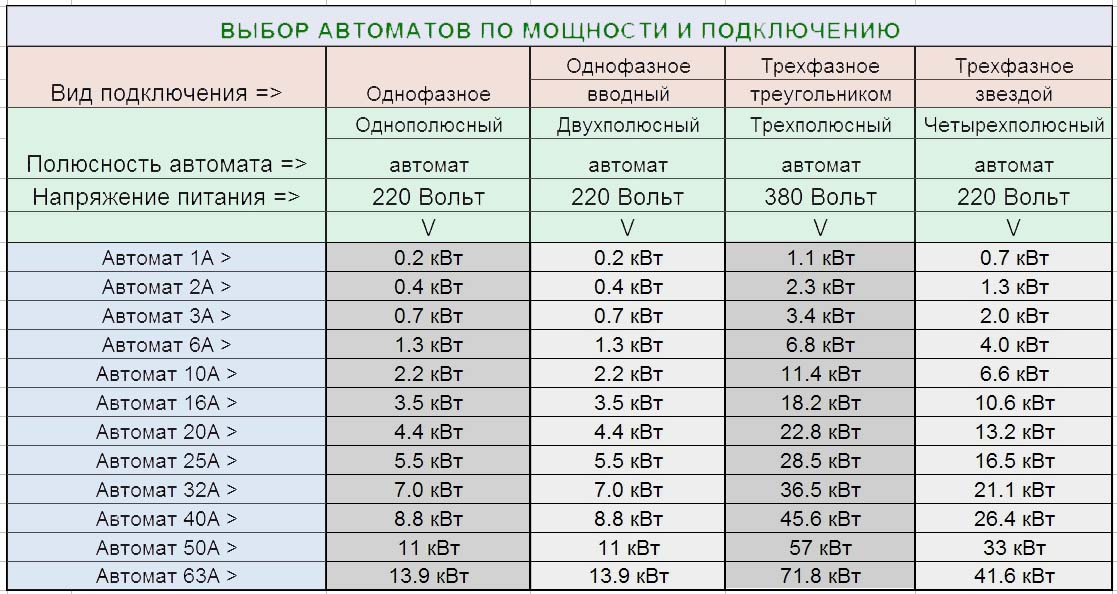
The table illustrates the maximum power of each modification of the machine, based on the wiring diagram and the mains voltage. The maximum output of the switch occurs when the load is connected by a triangle (+)
The choice of the switch according to this characteristic is made taking into account the power of the wiring, the permissible current that the wiring can withstand in normal mode. If the value of the current is unknown, it is determined by means of formulas using the data of the wire section, its material and the method of installation.
Automata 1A, 2A, 3A are used to protect circuits with low currents. They are suitable for providing electricity to a small number of devices, for example, a lamp or chandelier, a low-power refrigerator and other devices, the total power of which does not exceed the capability of the machine. Switch 3A is effectively operated in the industry if its three-phase connection is made by the type of a triangle.
Switches 6A, 10A, 16A can be used to provide electricity for individual circuits, small rooms or apartments. These models are used in industry, with their help supply power motors, solenoids, heaters, welding machines, connected by a separate line.
Three- and four-pole 16A automata are used as input for a three-phase power scheme. In production, devices with a D-curve are preferred.
Automatic machines 20A, 25A, 32A are used to protect the wiring modern apartments, they are able to provide electricity washing machines, heaters, electric dryers and other equipment with high power. Model 25A is used as an input automaton.
Switches 40A, 50A, 63A belong to the class of devices with high power. They are used to provide electricity power equipment of high power in everyday life, industry, civil engineering.
Selection and calculation of circuit breakers
Knowing the characteristics of AB, you can determine which machine is suitable for a particular purpose. But before the choice optimal model it is necessary to make some calculations, with which you can accurately determine the parameters of the desired device.
Step 1. Determination of the machine power
When choosing an automaton, it is important to consider the total power of the connected devices.
For example, you need an automatic device for connecting kitchen appliances to the power supply. Let's say a coffee machine (1000 W), a refrigerator (500 W), an oven (2000 W), a microwave oven (2000 W), an electric kettle (1000 W) will be connected to the outlet. The total power will be 1000 + 500 + 2000 + 2000 + 1000 = 6500 (W) or 6.5 kV.
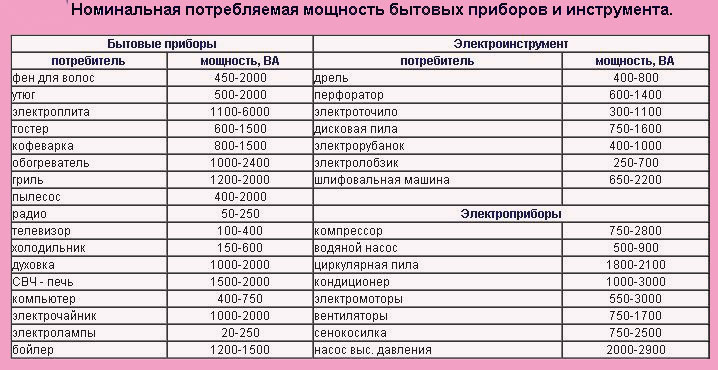
The table shows the nominal power of some household appliances necessary for their operation. According to the normative data, the cross section of the power wire for their power supply and the automatic device for protecting the wiring are selected (+)
If you look at the table of automatic machines for power connection, take into account that the standard voltage of the wiring in domestic conditions is 220 V, then a single-pole or two-pole automatic device 32A with a total power of 7 kW is suitable for operation.
It should be noted that more power consumption may be required, since other electrical appliances that were not initially taken into account may be required during operation. To provide for this situation, an incremental coefficient is used in the calculations of total consumption.
Suppose, by adding additional electrical equipment, an increase in power by 1.5 kW was required. Then it is necessary to take the coefficient 1.5 and multiply it by the calculated design power.
In calculations it is sometimes appropriate to use the reduction factor. It is used when simultaneous use of several devices is impossible. Let's say that the total wiring power for the kitchen was 3.1 kW. Then the reduction factor is 1, since the minimum number of devices connected simultaneously is taken into account.
If one of the devices can not be connected to others, then the reduction factor is taken less than unity.
Step # 2. Calculation of the rated power of the machine
Nominal power is the power at which disconnection of the wiring does not occur. It is calculated by the formula:
where M is the power (Watt), N is the mains voltage (Volts), CT is the current that can pass through the machine (Ampere), is the cosine of the angle that takes the value of the angle of shear between the phases and the voltage. The cosine value is usually 1, since there is practically no shift between the phases of the current and the voltage.
From the formula we express CT:
The power we have already determined, and the mains voltage is usually 220 volts.
If the total power is 3.1 kW, then
The resulting current will be 14 A.
For the calculation for a three-phase load, the same formula is used, but allow for angular shifts that can reach large values. Usually they are indicated on the connected equipment.
Step # 3. Calculation of rated current
Calculate the rated current can be according to the documentation for the wiring, but if it is not, then determine based on the characteristics of the conductor. The following data are required for calculations:
- section area of the conductor;
- used for vein material (copper or aluminum);
- method of installation.
In the home, usually the wiring is located in the wall.

To calculate the cross-sectional area, you need a micrometer or calipers. It is necessary to measure an exclusively conductive core, rather than wire and insulation
Having made the necessary measurements, calculate the cross-sectional area:
In the formula, D is the diameter of the conductor (mm),
S is the cross-sectional area of the conductor (mm 2).
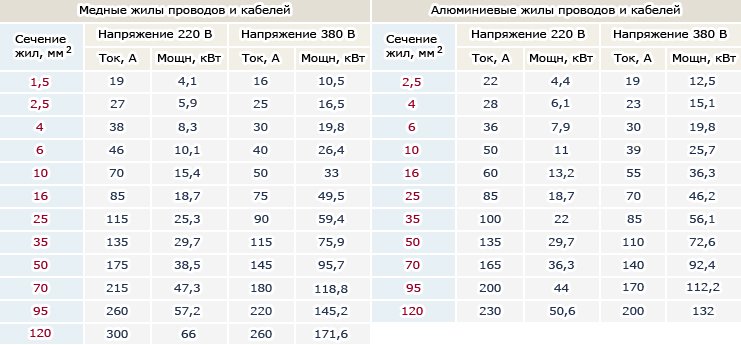
Having determined from what material the conductor veins were made, and having calculated the cross-sectional area, it is possible to determine the current and power indicators that the electric network wiring can withstand. The data is for wiring hidden in the wall (+)
Taking into account the received data, we select the operating current of the machine, as well as its nominal value. It must be equal to or less than the operating current. In some cases, it is allowed to use machines with a rating higher than the actual current of the wiring.
Step # 4. Determination of the time-current characteristic
In order to correctly determine the BTX, it is necessary to take into account the starting currents of the connected loads. The required data can be found using the table below.

The table shows some types of electrical devices, as well as the frequency of the starting current and the pulse width in seconds (+)
According to the table, you can determine the amperage (in Amperes) when the device is turned on, as well as the period through which the current limit will occur again.
For example, if you take an electric meat grinder whose power is 1.5 kW, calculate the working current from the tables for it (this will be 6.81 A) and, taking into account the multiplicity of the starting current (up to 7 times), we get the current value of 6.81 * 7 = 48 (A). The current of this force flows with a periodicity of 1-3 seconds.
Considering the graphs of the VTK for class B, it can be seen that, when overloaded, the circuit breaker will be activated in the first seconds after the mincer is started. Obviously, the multiplicity of this device corresponds to class C, so the machine with the characteristic C must be used to support the operation of the electric meat grinder.
For domestic needs, usually use switches that meet the characteristics of B, C. In industry, for equipment with large multiple currents (motors, power supplies, etc.), current is generated up to 10 times, so it is advisable to use D-modifications of the device. However, it is necessary to take into account the power of such devices, as well as the duration of the starting current.
Autonomous automatic switches differ from conventional ones in that they are installed in separate switchboards. The function of the device includes protection of the circuit from unexpected voltage surges, power outages in all or a certain part of the network.
Useful video for the selection of machines
Video # 1: Selection of AB by current characteristic and example of current calculation
Video # 2: Calculation of the rated current AB
The machines are mounted at the entrance of the house or apartment. They are located in plastic strong boxes. Given the basic characteristics of circuit breakers, as well as making the correct calculations, you can make the right choice of this device.


